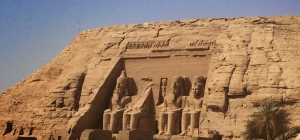The astounding temple of Ramses II raised from drowning in the lake behind the high dam in the 1960s by UNESCO. Its removal and resurrection are as much a story as its origins. These colossi appeared in the curve of the Nile to announce to any African traders that the Kingdoms of Upper and Lower Egypt were not to be messed with. The other astounding thing is that there are almost NO tourists here. Abu Simbal is a 45 minute flight from Aswan or a 4 hour convoy ride through the desert leaving at 4:00 AM. We are wimps and choose the plane.
Ramses II smiting his enemies, in this case Hittites in Asia Minor around 1270 BC. There is much smiting and trampling of enemies in all of these carvings which are in near perfect condition, protected by sand which filled the abandonned temple for 2,000 years, preserving it intact with faces unscathed by early Christians and roof not blackened by cooking fires, as in many other temples.
The spectacular setting of Kom Ombu overlooking the West bank of the Nile. We are literrally the only people here.The “Nile meter” (a huge well dug next to the temple on the banks of the river) recorded the annual spring floods and allowed the grand viziers to determine in advance how successful the harvests would be and how much tax they could raise, thereby predicting revenues and budgets.
A panel showing the birthing room and chairs and a display of surgical instruments used in 370 BC.
Edfu, the most intact ancient temple in Egypt; and probably in the world. Ptolemaic (350s BC). And again, the huge parking lot is empty, and we are two of maybe 8 people in the entire temple. The effect of the loss of tourism (13% of the Egyptian economy) has decimated the local economy.
The island temple of Philae dedicated to Isis (the goddess, not the bad guys), saved by UNESCO from its sunken island nearby which is now compleely submerged after completion of the Aswan high dam. It is one of the prettiest temple sites in Egypt and dates from 200 BCE – 100 CE, started under the Prolemies and with a Roman temple extension. It was used by Coptic Christans for centuries and many of the original carvings have been defaced. Several store rooms were used as churches and coptic crosses are carved into the walls. Early French visitors from the time of Napolean have scratched their names and dates into the walls. (Jacques was here! 1806.)






